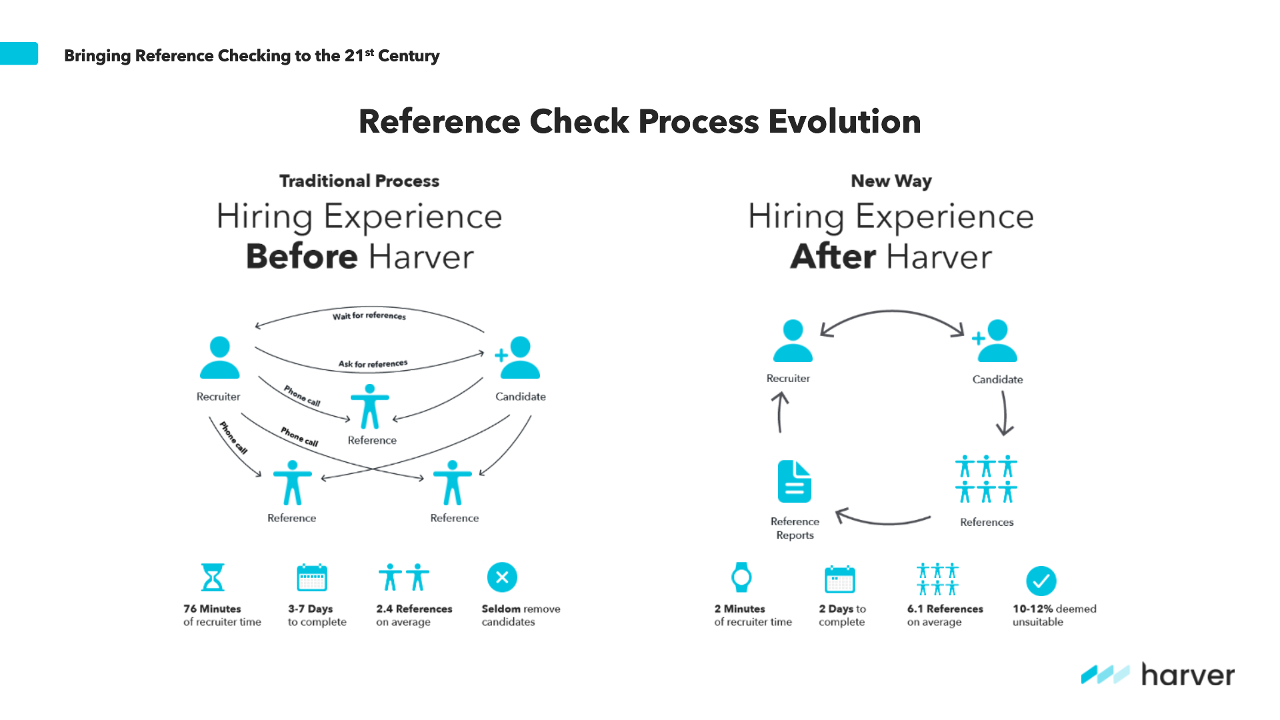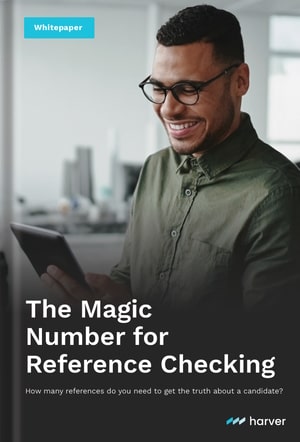Like reference checking, the sport of baseball has a perception of being S-L-O-W. Even when you find an all-star candidate, you know how it goes. “Maybe this reference will finally pick up.” But then you keep striking out, call after unanswered call.
If you couldn’t tell yet, I’m a talent professional who loves baseball. (Go San Francisco Giants!) While the sport can be seen as slow, recent innovations such as adding a pitch clock have sped up the game.

Traditional reference checking needed innovative help, too. That’s why I’m so excited to share how automated reference check software, like Harver’s reference checking solution Checkster, can enable more efficient and effective strategies and processes for talent teams.
Ready to play ball? Keep reading for five reasons why automated reference check software is a home-run success for busy recruiters.
What's in?
Reference checks: the “Moneyball” way to evaluate talent
If you’ve seen the movie Moneyball starring Brad Pitt, you know that objective data can help build a successful baseball team. With recruiting, evaluating talent is just as important.
One reason Pacific Retirement Services uses Checkster is because references can be like scouts in baseball and candidates are prospects hoping to join the team. Their candid feedback on work history is like a scouting report, helping to benchmark a candidate compared to what we see during a “game” or an interview.
For instance, we recruit thousands of nurses and caregivers across our 14 locations. With healthcare hiring, we need that validation of “you’re a caring person and we can trust you to care for our residents.” Other folks tend to be better at seeing our strengths and weaknesses.
HR lesson from Brad Pitt: Adapt or die

In Moneyball, a team with limited resources needed to adapt to stay competitive. Sound familiar, fellow talent professionals in 2024?
When I took over systems and processes at Pacific Retirement Services, I knew the importance of reference checking. I also knew we needed to get with the times. Our old reference checking process contributed to HR being thought of as simply transactional tasks.
Our old reference checking process
- During application, candidates filled out a reference check form
- An HR generalist would chase down the 3-4 people via phone calls
- We weren’t collecting email addresses, so we had to call people multiple times
- Even after repeated calls, we often had to circle back for fresh references
- When we did manage to reach a reference, we had to manually type out feedback
Waaaaaaay too slow to effectively compete with other employers trying to hire the same talent. We needed to substitute in a pinch runner with faster legs.
Enter the power of automated reference checking.
Our modern reference checking process with Checkster
- No need for forms – candidates own the process of submitting contact information
- No need for calling people – setting up an automated survey takes just 2 minutes
- Better response rate – we get more responses in less time, instead of having to go back to candidates asking for alternate references
- Big reduction in paperwork – and shift away from the perception that HR is just paperwork
- Candidate owning process is so helpful – gives us a sense of “is candidate a self-starter?”

Number of pitches vs number of references
A baseball pitcher has one job: get three “outs” by preventing three opposing players from successfully hitting the ball. Generally, pitchers seek “pitch count” efficiency by throwing the ball as few times as possible to stop an opposing batter.
Our small yet might recruiting teams at Pacific Retirement Services also strive for efficiency. When it comes to reference checking, we require a minimum of 3 references to help maintain anonymity. With Checkster’s automated reference checking, we don’t need to stress about “throwing enough pitches.”
Now we get enough references, including at least one current or former supervisor. Before we partnered with Harver, reference checks used to be an epic stalemate between pitchers (us) and batters (busy references). We’d try to track people down for days, losing top talent in the slow process. With Checkster, the added speed of completing reference checks in a day or two has greatly reduced drop-off.
Pairing speed with strategy
My favorite player is Madison Bumgarner. He’s a three-time champion with a good fastball. Yet he’s more than speed – he also effectively uses pitching strategy to win.
Because sometimes you just need a curveball.
For example, Pacific Retirement Services moved reference checking earlier in the process for higher level roles. Like a 90-mile fastball setting up the next pitch of a tricky curveball, the speed of gathering feedback with Checkster enabled this shift in approach. Now we get to use reference check feedback as well-rounded data to inform final interviews.
For director and up roles, now we ask for references during the interview and collect candid feedback in time for final panel review. Sometimes we hear from a direct report that a candidate has a “heavy-handed management style.” That’s when we follow up by asking the candidate how they’d adjust behaviorally to use a lighter touch.
Regarding what to ask when checking references, I love asking, “How have you grown as an individual working with this person?” Because Pacific Retirement Services has grown a lot via acquisitions, we emphasize vision buy-in. We need leaders and “coaches” more than we need task masters and specialty players.

The value of coaching and development
In baseball, developing skills and closing gaps is just as important as natural athletic ability. It’s no different for talent management.
The feedback we get from Harver’s automated reference checking tool helps give us a well-rounded view of candidates. These insights into work history from supervisors and peers help support our developmental coaching. Hiring managers use this background knowledge for a sense of how the new employee will operate on day 1.
Our training plans are regimented, so new hires tend to be 30-60 days out from working on their own. We find that incorporating reference feedback into coaching helps new hires onboard faster and integrate with their team better. During training, this initial feedback from former colleagues helps managers set expectations and adapt even subtle measures to personalize coaching.
Turning reference checking software into a home run
Just like old timey baseball was way too slow (they didn’t even wear gloves!), traditional reference checking is from a bygone era. It’s time for competitive employers to “step up to the plate” and “knock it out of the park” with automation.
To learn more about reference checking software, take a swing at Harver’s automated solution Checkster.


